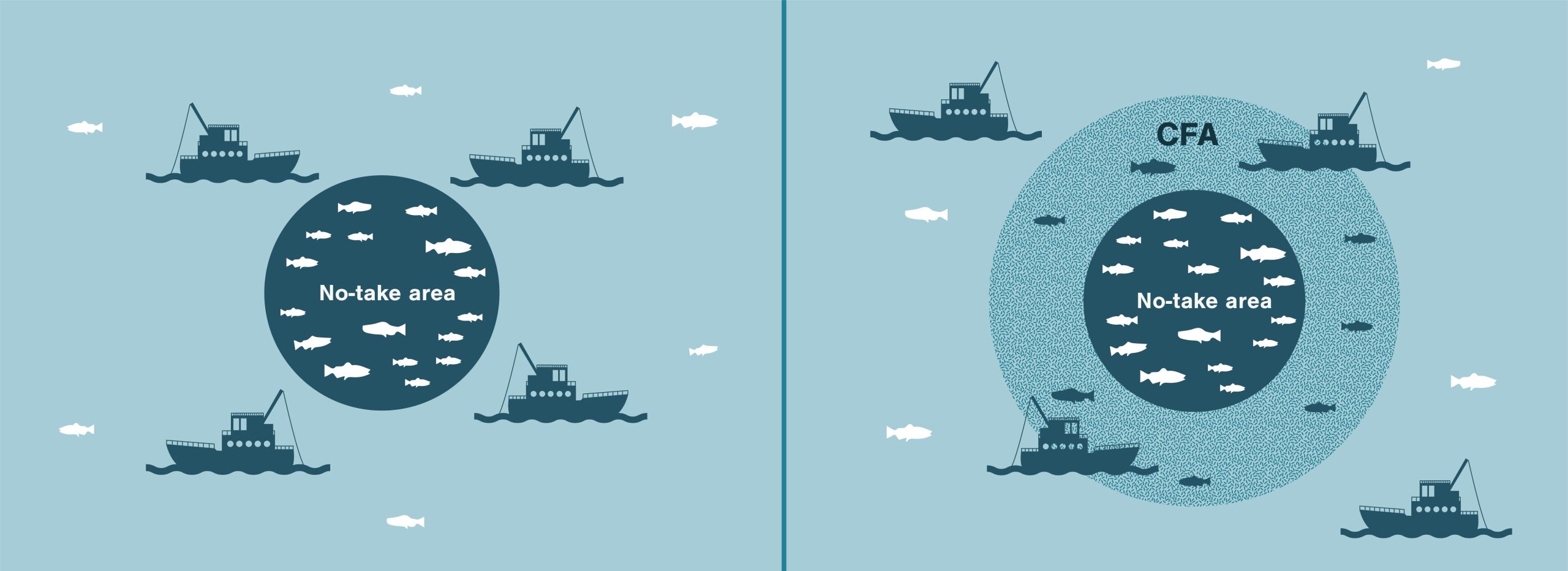How Marine Protected Areas Can Pay for Their Own Protection
Funding the surveillance efforts needed to effectively monitor and enforce a marine protected area (MPA) is challenging. Scientists have come up with a way they say MPAs can pay for themselves. Photo by Wild Wonders of Europe/Widstrand/NPL/Minden Pictures
The area right next to a marine protected area is a prime fishing spot—and researchers think fishermen will pay to access it.
Authored by
byWordcount
December 22, 2021 | 800 words, about 4 minutesArticle body copy
Overfishing is one of the greatest threats to biodiversity in the ocean, and according to a recent United Nations report a third of global fish stocks are overfished. One answer to the problem of overfishing is to implement marine protected areas (MPAs)—parcels of ocean where fishing is banned or severely restricted. When well designed, MPAs allow time for species to recover and can even increase the amount of fish available to fishermen in neighboring waters. These no-take zones, however, are vulnerable to poaching.
Protecting an MPA from poachers is daunting and expensive. It requires round-the-clock monitoring—by drones, satellites, or something else—and at-sea patrols by law enforcement. Paying for all of this is a challenge, with funding provided through philanthropy, by the government, or users fees from tourism activities like diving.
A new report by University of California, Santa Barbara, graduate student Juan Carlos Villaseñor-Derbez and his colleagues, however, proposes a counterintuitive way to make MPAs financially self-sufficient: charge a limited number of fishermen for premium access for the right to fish just outside these particularly bountiful no-take zones.
“Fish, of course, don’t recognize boundaries,” says Villaseñor-Derbez—especially not the lines that prevent law-abiding fishermen from plying inside an MPA or a country’s exclusive economic zone. Consequently, fishing boats tend to gather at the very edge of a protected area, benefiting from the spillover of recovered species from inside the no-take zone.
Villaseñor-Derbez’s proposal is to turn the area just outside a no-take zone into a conservation finance area (CFA)—essentially commodifying existing fishing patterns around restricted areas. Charging for this access, Villaseñor-Derbez says, could raise enough money to efficiently finance enforcement measures and better protect the core no-take zone from poaching.
While some schemes have financially exploited fishermen’s tendency to line up along the boundary of a no-take zone—most notably the Parties to the Nauru Agreement, which charges purse seiners for the right to fish tuna outside protected zones—none so far have done so with the goal of enhancing conservation. Villaseñor-Derbez says his paper provides a template that, if implemented, could fuel the global expansion of marine protected areas.

A recent paper proposes that the creation of a conservation finance area (CFA), which would charge fishermen for access to the area just outside a no-take marine protected area, could raise enough funds to pay for enforcement measures within the no-take zone. Currently, fishermen tend to fish on the borders of marine protected areas. This approach would commodify that practice without shrinking the size of the existing protected area. Illustration by Mercedes Minck
For Peter Jones, an expert in MPAs at University College London in England, Villaseñor-Derbez’s idea is an interesting proposal. “This would be a mechanism for ramping up the surveillance effort,” says Jones. Nevertheless, he fears the CFA would have to be situated within the most productive range of a given fish to justify its existence. That would mean harvesting in the CFA would reduce the density in the no-take zone, says Jones, which erodes the reasoning behind instituting an MPA in the first place.
This risk, argues Villaseñor-Derbez and his coauthors, would be offset by the reduction in poaching arising from the higher enforcement funding. The CFA model, though, is malleable. Once implemented, says Villaseñor-Derbez, it remains up to local authorities to balance the price of admission and the size of the CFA to ensure that the species residing in the core of the MPA remain protected.
Another serious challenge that Jones envisions to the scheme’s implementation is its likely unpalatability to global fishing communities. While subject to territorial restrictions and quotas, fish are generally seen by fishermen as a freely exploitable public resource. The introduction of CFAs would effectively privatize fish and be seen as “a huge step” that Jones argues “would cause a huge backlash.” (Conversely, companies that extract other resources on public lands, such as trees and minerals, typically pay a fee or tax.)
Villaseñor-Derbez acknowledges that this is a challenge facing any implementation of a CFA model. Nevertheless, he says, the idea may be more palatable than one might initially suspect. A CFA would represent an expanded opportunity to exploit the spillover of fish from within an MPA, he says, when compared to a strict no-take zone.
There is one other huge potential flaw with the CFA scheme that Villaseñor-Derbez and his colleagues explore in their paper: its susceptibility to corruption. Poachers, for example, could conceivably bribe corrupt MPA authorities to look the other way while they slip into the pay-to-fish area or even the no-take zone. Less affluent fishermen might also be pushed into poaching if they judge the price of the leases as prohibitively high. Indeed, if the model is to work, says Villaseñor-Derbez, local authorities will have to carefully balance the price of admission with the conservation needs of the overall MPA.
Article footer and bottom matter
Sign up for the weekly newslstter
Sign up for our weekly newsletter
Additional Contributors
Edited by:
Colin Schultz
Author bio
Greg Noone is a writer and editor at NS Media Group, and lives in Cambridge in England. His work has also appeared in The Atlantic, New York magazine, and The Guardian.

Tags
Topic:
Policy & LawCite this Article:
Cite this Article: Greg Noone “How Marine Protected Areas Can Pay for Their Own Protection,” Hakai Magazine, Dec 22, 2021, accessed December 22nd, 2021, https://hakaimagazine.com/news/how-mpas-can-pay-for-their-own-protection/.
By accepting you will be accessing a service provided by a third-party external to https://oc3anclub.com/

